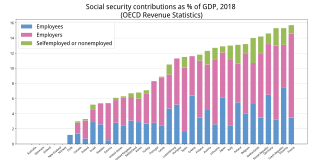Related Research Articles

A community is a social unit with a shared socially-significant characteristic, such as place, set of norms, culture, religion, values, customs, or identity. Communities may share a sense of place situated in a given geographical area or in virtual space through communication platforms. Durable good relations that extend beyond immediate genealogical ties also define a sense of community, important to people's identity, practice, and roles in social institutions such as family, home, work, government, TV network, society, or humanity at large. Although communities are usually small relative to personal social ties, "community" may also refer to large-group affiliations such as national communities, international communities, and virtual communities.
Communitarianism is a philosophy that emphasizes the connection between the individual and the community. Its overriding philosophy is based on the belief that a person's social identity and personality are largely molded by community relationships, with a smaller degree of development being placed on individualism. Although the community might be a family, communitarianism usually is understood, in the wider, philosophical sense, as a collection of interactions, among a community of people in a given place, or among a community who share an interest or who share a history. Communitarianism is often contrasted with individualism, and opposes laissez-faire policies that deprioritize the stability of the overall community.
Social capital is "the networks of relationships among people who live and work in a particular society, enabling that society to function effectively". It involves the effective functioning of social groups through interpersonal relationships, a shared sense of identity, a shared understanding, shared norms, shared values, trust, cooperation, and reciprocity. Some have described it as a form of capital that produces public goods for a common purpose, although this does not align with how it has been measured.

Microfinance consists of financial services targeting individuals and small businesses who lack access to conventional banking and related services. Microfinance includes microcredit, the provision of small loans to poor clients; savings and checking accounts; microinsurance; and payment systems, among other services. Microfinance services are designed to reach excluded customers, usually poorer population segments, possibly socially marginalized, or geographically more isolated, and to help them become self-sufficient. ID Ghana is an example of a microfinance institution.

Corporate social responsibility (CSR) or corporate social impact is a form of international private business self-regulation which aims to contribute to societal goals of a philanthropic, activist, or charitable nature by engaging in, with, or supporting professional service volunteering through pro bono programs, community development, administering monetary grants to non-profit organizations for the public benefit, or to conduct ethically oriented business and investment practices. While once it was possible to describe CSR as an internal organizational policy or a corporate ethic strategy similar to what is now known today as Environmental, Social, Governance (ESG); that time has passed as various companies have pledged to go beyond that or have been mandated or incentivized by governments to have a better impact on the surrounding community. In addition, national and international standards, laws, and business models have been developed to facilitate and incentivize this phenomenon. Various organizations have used their authority to push it beyond individual or industry-wide initiatives. In contrast, it has been considered a form of corporate self-regulation for some time, over the last decade or so it has moved considerably from voluntary decisions at the level of individual organizations to mandatory schemes at regional, national, and international levels. Moreover, scholars and firms are using the term "creating shared value", an extension of corporate social responsibility, to explain ways of doing business in a socially responsible way while making profits.

Robert David Putnam is an American political scientist specializing in comparative politics. He is the Peter and Isabel Malkin Professor of Public Policy at the Harvard University John F. Kennedy School of Government.
A need is dissatisfaction at a point of time and in a given context. Needs are distinguished from wants. In the case of a need, a deficiency causes a clear adverse outcome: a dysfunction or death. In other words, a need is something required for a safe, stable and healthy life while a want is a desire, wish or aspiration. When needs or wants are backed by purchasing power, they have the potential to become economic demands.
Community psychology is concerned with the community as the unit of study. This contrasts with most psychology, which focuses on the individual. Community psychology also studies the community as a context for the individuals within it, and the relationships of the individual to communities and society. Community psychologists seek to understand the functioning of the community, including the quality of life of persons within groups, organizations and institutions, communities, and society. They aim to enhance the quality of life through collaborative research and action.

Bowling Alone: The Collapse and Revival of American Community is a 2000 nonfiction book by Robert D. Putnam. It was developed from his 1995 essay entitled "Bowling Alone: America's Declining Social Capital". Putnam surveys the decline of social capital in the United States since 1950. He has described the reduction in all the forms of in-person social intercourse upon which Americans used to found, educate, and enrich the fabric of their social lives. He argues that this undermines the active civic engagement which a strong democracy requires from its citizens.

Social insurance is a form of social welfare that provides insurance against economic risks. The insurance may be provided publicly or through the subsidizing of private insurance. In contrast to other forms of social assistance, individuals' claims are partly dependent on their contributions, which can be considered insurance premiums to create a common fund out of which the individuals are then paid benefits in the future.
A social enterprise is an organization that applies commercial strategies to maximize improvements in financial, social and environmental well-being. This may include maximizing social impact alongside profits for co-owners.

Civic engagement or civic participation is any individual or group activity addressing issues of public concern. Civic engagement includes communities working together or individuals working alone in both political and non-political actions to protect public values or make a change in a community. The goal of civic engagement is to address public concerns and promote the quality of the community.
Community building is a field of practices directed toward the creation or enhancement of community among individuals within a regional area or with a common need or interest. It is often encompassed under the fields of community organizing, community organization, community work, and community development.

Better Together: Restoring the American Community is both a book and website published as an initiative of the Saguaro Seminar conducted at Harvard University's John F. Kennedy School of Government. The initiative is aimed at facilitating rapid and extensive community development, particularly within the United States and uses a book with the same title by Robert Putnam and Lewis M. Feldstein as its primary reference text.

Community Education, also known as Community-Based Education or Community Learning & Development, or Development Education is an organization's programs to promote learning and social development work with individuals and groups in their communities using a range of formal and informal methods. A common defining feature is that programmes and activities are developed in dialogue with communities and participants. The purpose of community learning and development is to develop the capacity of individuals and groups of all ages through their actions, the capacity of communities, to improve their quality of life. Central to this is their ability to participate in democratic processes.
The gort cloud is "a vast, largely invisible and growing (environmentally-aware) 'community' that sieves, measures and exchanges information on environmental (green) products and services." "The community includes NGOs, government agencies, certifying groups, academics, eco-tech specialists, business alliances, green media including green business news, sustainable designers, foundations, other social networks, conferences, trade shows, events, competitions, green blogs, special interest groups, and trendspotters—to name just a few." The book, "The Gort Cloud", examines the marketing and brand-building experiences of sustainable businesses in America and discusses the gort cloud concept. It was critically reviewed by TreeHugger in December 2008.

Lyda Judson Hanifan, better known as L. J. Hanifan, is credited with introducing the concept of social capital. Robert Putnam in his book, Bowling Alone (2000) credits a 1916 paper by Hanifan as the first recorded instance of the term. Hanifan also authored a book published in 1920 that contains a chapter entitled "Social Capital".
A sustainability organization is (1) an organized group of people that aims to advance sustainability and/or (2) those actions of organizing something sustainably. Unlike many business organizations, sustainability organizations are not limited to implementing sustainability strategies which provide them with economic and cultural benefits attained through environmental responsibility. For sustainability organizations, sustainability can also be an end in itself without further justifications.
A community is "a body of people or things viewed collectively". According to Steven Brintgregates of people who share common activities and/or beliefs and who are bound together principally by relations of affect, loyalty, common values, and/or personal concern – i.e., interest in the personalities and life events of one another".
Social engagement refers to one's degree of participation in a community or society.
References
- ↑ Beck, U. 1992. Risk Society: Towards a New Modernity. London: Sage
- ↑ Melissa M. Ahern, Michael S. Hendryx, Kris Siddharthan Medical Care, Vol. 34, No. 9 (Sep., 1996), pp. 863-986
- ↑ Chavis DM, Wandersman A. Sense of community in the urban environment: A catalyst for participation and community development. Am J Community Psychol 1990;18:55.
- ↑ McMillan DW, Chavis DM. Sense of community: A definition and theory. J Community Psychol 1986;14:6.
- ↑ Sustaining Community-Based Programs for Families: Conceptualization and Measurement Jay A. Mancini, Lydia I. Marek. Family Relations , Vol. 53, No. 4 (Jul., 2004), pp. 339-419.
- ↑ Putnam, Robert D. Bowling Alone: the Collapse and Revival of American Community. New York: Simon & Schuster, 2000. pp.21,289-290.
- ↑ Lyda Judson Hanifan, "The Rural School Community Center," Annals of the American Academy of Political and Social Science 67 (1916): 130-138, quotation at 130. Found in Putnam, Robert D. Bowling Alone: the Collapse and Revival of American Community. New York: Simon & Schuster, 2000. Print.a
- ↑ Putnam, Robert D. (2000), p.90. Referencing: Jeanne S. Hurlbert, "Social Networks, Social Circles, and Job satisfaction," Work and Occupations, 18 (1991): 415-438; Randy Hodson, "Group Relations at Work: Solidarity, Conflict, and Relations with Management," Work and Occupations 24 (1997): 426-452; Ronnie Sandroff, "The power of Office Friendships," Working Mother (November 1997): 35-36, and the works cited there.
- ↑ Putnam, Robert D. (2000), pp.297-308.
- 1 2 3 Putnam, Robert D. (2000), p.326.
- ↑ Putnam, Robert D. (2000), p.332.
- 1 2 LaFond, A. K. (1995). Improving the quality of investment in health: Issues on sustainability. Health Policy and Planning (Suppl. 10), 63-76.
- 1 2 Sustaining Community-Based Programs for Families: Conceptualization and Measurement Jay A. Mancini, Lydia I. Marek. Family Relations, Vol. 53, No. 4 (July, 2004), pp. 339-419.
- ↑ Top Ten Reasons to Buy Local Archived 2010-03-07 at archive.today , Sustain South Sound, Washington, USA.